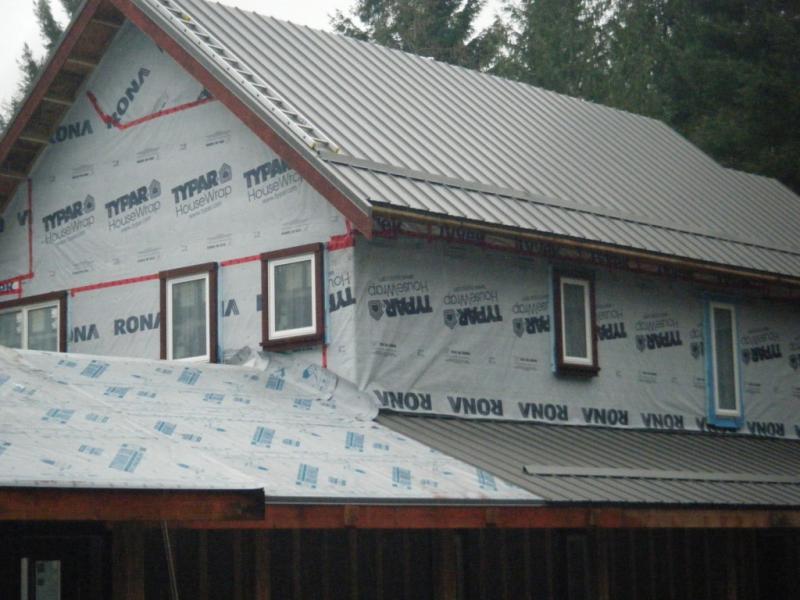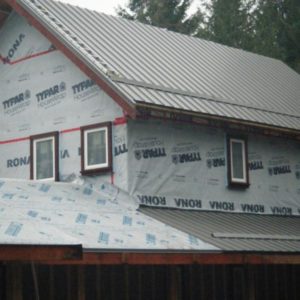A Forest Fire Resistant Home: Metal Roof and Soffits, Fiber Cement Siding – other thoughts?
In May 2011 a large part of Slave Lake, Alberta burned to the ground and before that there was the Kelowna area fire. In the news right now, a town in Tasmania Australia burned down and the fire rating there is catastrophic. I am currently building and am interested in taking some measures to give my home a fighing chance if we are called to evacuate due to a fire and would welcome some ideas.
House Construction Details that Minimize Risk from Forest Fires
Right now we are off to a good start as the metal roof is being installed and you can follow our blog A Green Hearth for the details of that progress and our other efforts. The rest of the house is being blanketed with 2″ Roxul Comfortboard IS (rigid board rock wool insulation) which will then be covered with fiber cement siding. The soffits will be aluminum, though we will have cedar trim around the vinyl windows and fiberglass doors, barge boards and corner trim. Some of the window are triple pane which should help with the cracking issue. If I had time I could mount some mineral wool and sheet metal shutters with a 1″ space built in. I read in the Colorada Passive House Symposium proceeedings about fused roof vent screens which apparently melt shut to keep out sparks. There is some kind of plastic mesh blocks that came with the roof for the ridge vents (maybe they are fused vents) and I plan to use fine metal mesh over the gable end vents to keep out embers (and will look into fused vents there too). The blown in cellulose insulation planned for the attic has added borax which is supposed to effectively suppress fire, but it would take a lot to get fire into the attic. I could put down some mineral wool near the vents. There is a covered porch with some exposed posts and beams though. Hopefully the concrete around them and the driveway will be enough protection.
Creating a Fire Defensible Zone Around Your House
We will have gardens, lawn, concrete flagstone patios and a pond around the house, but due to a narrow lot, there are taller trees on one side. We can clear about 20 meters on that side and more on most of the other sides. I think a swath around the house with pure gravel over some kind of barrier would help keep grass fires from lapping at the sides of the house. I plan to make up a fire wagon with a pump to draw water from the pond and that could be used to fight small fires or at least set up a sprinkler system on the house and area. Other ideas? (We are on Vancouver Island, BC in a rural treed neighbourhood near a small village.)
Resources for Protecting Your Home from Forest Fires
I found useful documents on fire prevention from the BC Wildfire Management Branch and Colorado State University’s document on Rural Home Fire Protection and their related web page.





















Replies
Breaking your posts up into paragraphs makes them a lot more readable.
Breaking your posts up into paragraphs makes them a lot more readable.
Yep, and it also makes them less likely to be taken for spam.
As I understand it, the fused roof vents contain a thermal "fuse" that melts (at relatively low temperature) to cause the vents to close in a fire.
As you no doubt have heard (given you mentioned screened vents), often an otherwise fire-resistant house catches fire because hot embers are drawn into the attic through roof vents. I'm not sure what's considered "best practice" to prevent this problem, but the fused vents are one option. It's not clear that screens alone are sufficient.
Patrick
I sure hope you start keeping these separate portions of your build in one place-one folder.
It'll be easier to follow along.
thanks.
Consider your decking choices carefully
You didn't mentin a deck on your home so I don't know if this applies, but you should carefully consider your choice of decking. Some productsare more fire resistent than others.
Here's some light readng (ha ha- get it?)
http://www.deckmagazine.com/safety/decks-in-the-line-of-fire.aspx
I have nothing to offer that you haven't already thought of, just an attaboy for your thoughtful approach. Your chances of the place surviving a forest fire are hugely better than conventional methods, and it appears that the increased cost is not unreasonable.
Do you know if you can get any insurance discount as a result?
http://www.firewise.org/
The vents are important as noted above, and I believe windows can be vulnerable to cracking.
Basically plan on a lot of tree trimming and clearing to keep fuel down and remove paths from a ground to a canopy fire.
Talk to the Experts
Have you spoken to your insurance company? I'll bet they have some ideas.
Your first, and biggest, issue is the space aroud your home. Minimum 30 ft. of CLEAR space. That means nothing more than a mown lawn, no pine needles, no bark mulch,no shrubs. Other neaby plants should be healthy and fire resistant. For example, oak trees are not nearly as flammable as pine trees, and eucalyptus trees burn like an oil well. Trees should not overhang the 'clear space' and defeat the purpose.
Next, there are the house materials. Various assemblies - not just individual materials - are rated for fire exposure to different degrees. For example, a UL-listed "Type A" roof is a lot more fire resistant than a "Type C" roof. It's more than just the surface materials; metal doesn't help if it transmits all the heat direct to the flammable insides.
Archiectural details matter, but you're pretty much stuck with what you have. Low pitch roofs with valleys are bad, big overhangs are bad, etc.
Don't forget what's INSIDE your home. Let's assume fire gets in - through a broken window, perhaps. Now what? Will an ember land on flammable carpet, and ignite thin cotton drapes and a foam-filled sofa? Hello, inferno!
What will you do? Apart from having a 'grab and go' kit, you should consider having some manner of extra-fire-resistant place where you can stash the papers and keepsakes you can't carry. A "coffin" made with 2" of drywall all around will survive one hell of a fire. Essentials - passports, property deeds, etc- belong in a real bank's safety deposit box.
Don't forget the pets- have carriers and transport at hand for all of them .... or you'll have to leave fluffy behind.
Since the fire crews want you to leave the house unlocked, you might want to have a proper safe. Not everyone is an angel. In last winter's fires in Reno, the fire crews on the way out met the thieves coming in. Many arrests were made. Don't count on the authorities to catch them all.
Various things, like water misters on roofs, have been tried with some success. The problem is that water and power may not be available. When everyone on the street starts hosing off their roofs, the water supply is soon kaput.
Finally, arrange a meeting point and communication plan for your family afterwards. Very often folks are separated by these fires, and much anxiety follows as everyone stumbles about looking for each other. Pick a place fairly away from home, on the other side of the ridge, across the river. For example, the east parking lot of the supermarket. Have everyone call Aunt Nancy in the next town and let her act as a clearinghouse of who is where.
I also recall hearing that there are certain shrubs that can be planted that are highly fire-resistant.
If you have a pond, then a gas powered pump and a sprinkler system would seem like one method to insure against a forrest fire. Around here, the rural fire depts put fire hose capable PVC pipes into ponds and lakes near subdivisions. You could install a similar pvc standpipe to hook a pump up to. I think they run route them the deepest point they can reach in the pond and then turn the inlet section up a foot or two so it doesn't get any sediment clogs. You could connect this to an inground sprinkler system which waters your green space or to misters that water your house.
Thanks for all of the fire prevention tips
Thank you! I think we can get an insurance reduction based on roofing and siding choices. We will have no wood decks, just concrete / flagstone patios that don't rot and don't burn.
If you are in a fire zone, I would say your best bet is to PLAN for fire.
I wouldn't ventalate the roof at all - instead I would go with a highly insulated catherdral ceiling instead... but probably too late now.
The thermally fused stuff is interesting, but also a potential weakness: Either it fails because the chemical components change over time, or it fails by closing without a fire, again due to decomposition.
I would think about a flash reduction system: A sprinkler system that's just supposed to fogg the house & surrounding area with water for 10/20 minutes while a fire front passes. Plan for a 60MPH wind.
You can do an unvented attic without a cathedral ceiling too.